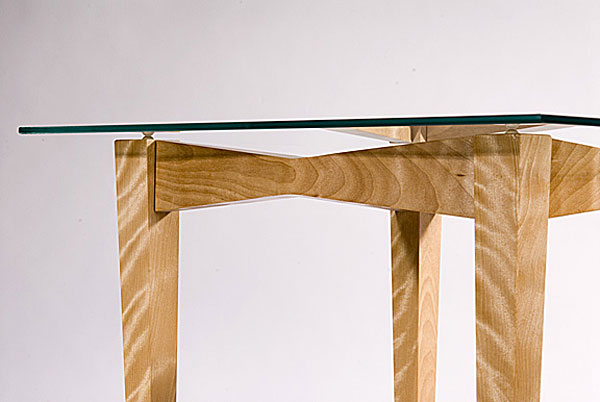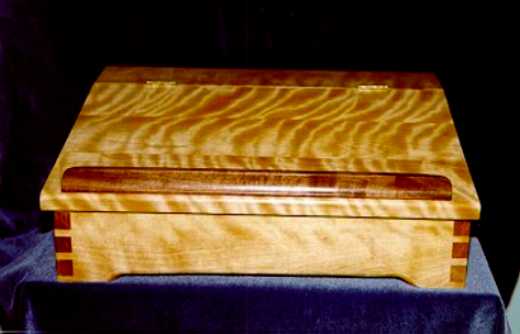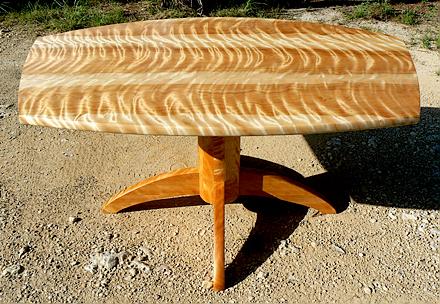Yellow birch is one of those woods you see quite a bit. It’s been used as the veneer of basic cabinet grade plywood. It’s been one of the go-to woods for kitchen cabinets for decades. And, any boy scout or girl scout worth their merit badge will tell you the bark is an excellent tinder for starting a fire.
But, have you truly seen the flame?
Flame birch – also known as figured or curly birch – is seen very rarely in this valuable species. Just as with curly maple, the board exhibits quite dramatic waves through the sawn boards. The only difference is that it is much wider and bigger than curly maple. According to Eric Poirier at Bell Forest Products, “It looks more like figured cherry with wider bands of curl. I also love the color variation you see in the timbers. Birch sapwood is quite blond – similar to maple – and the heartwood is rather red like cherry.”
Because flame birch’s figure is over a much larger scale, it shines in big projects such as tabletops, bar tops and other flat surfaces. In smaller projects, you aren’t going to get the same effect. “In those cases, curly maple will give you a much better result, as the figure works in a much smaller scale.”

As with other figured woods, flame birch does require a great deal of care when it’s worked with. “It is very susceptible to tear-out and does not respond well to production milling. Slow speeds, sharp bits and grain direction all play an important role in milling this stuff properly. Drum sanders work great for thickness planing. Sharp hand tools are also very effective.”
The stresses that helped make the figure in the first place also tend to make the boards more prone to warping. “We’ll see most of the warping take place during the kiln drying. However, once it’s dry, the movement is going to be minimal. Even so, it’s best to adjust your plans to accommodate this kind of movement.”

While the wood does have its frustrating moments during construction, once you apply the finish all will be forgiven. “Just about any type of finish will bring out the figure in wood, but some are said to work better than others. Boiled linseed oil is supposed to be one of the best. Some types of finish will bring out the figure and give the wood more of a yellow or amber color – shellac, oil-based polyurethane or lacquer, and penetrating oils. If you want to keep the wood as close to the natural color as possible, I would recommend using a water-based polyurethane or lacquer.”
Finding flame birch does take a bit of detective work on behalf of the sawyer. “There are graders in local log concentration yards that look for and set aside these figured logs. They go through millions of board feet per year, so with that huge volume it makes sense that they find all the good stuff!”
Once the exceptionally figured woods are discovered and local sawmills are notified about the product, that’s when Eric and company will travel to these yards and bid on the logs. “We want to find the best to ensure woodworkers have plenty of this stuff for their projects.”
Currently, Bell has quite a bit of 4/4 flame birch on hand. But, a recent trip to one of these log auctions netted them some large specimens that allowed for 8/4 boards to be sawn. “Right now, it’s drying in the kiln. It should be ready right around Halloween… so it looks like our customers are in for a real treat! No tricks, we promise.”


Wow, that’s some gorgeous wood. I would LOVE to have a bar top made from that … well, that or some waterfall bubinga:)
That is an incredible tabletop! Excellent work. I am thinking about ordering some flame birch and that may have put me over the top.
How big is a board? I make ornaments and small boxes. A couple of board feet of 4 quarter would do for me.
Can you tell me how to bring out the figuring and get a dark color? I am replacing the dark stained flame birch that I lost in a fire in my 111 year old house. I’m not sure if it was dyed or stained , but did have shellac over it.
Hit it with some shellac, then sand it down with 320 grit paper. Follow it up with two or three coats of an oil-rich finish.
How would one cut for the flame fiqure. I have seen it in my birch logs. Does quarter sawing bring it out ? Or is it jst random.
Surprisingly, it appears on flat sawn boards! Who knew …